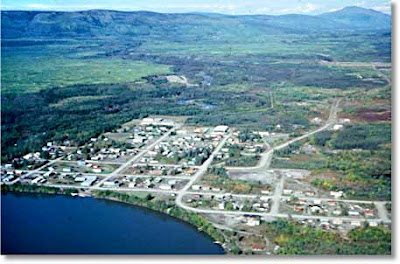 |
Mayo Connections. Accessed: 2011 October 16. http Mayo Village (elevation 1654 ft, lat 63.6°, long 135.9° W) is a subarctic, continental polar region within Canada's Yukon Territory. This tiny civic center is famed in the Yukon for being the "coldest and driest" during the winter and the "hottest and most wet" during the summer. Mayo's annual average is 29° F with an average precipitation of 1.1 in the form of rain, 5 in in the form of snow, and an annual range hovering around 70° F (wow!). The village sits in a polar "heat sink" zone; an area where the concentrated energy of the equator is dissipated on its journey toward the poles. |
 |
Mayo A., YT Canada: Climat, Global Warming and Daylights Charts and Data. 2010 Climate-charts.com Accessed: 2011 October 16. http://www.climate-charts.com/Locations/c/CN71965021007000.php Mayo earns the fame of being the "coldest and driest" due to the lack of sunlight, a semi permanent overlying pressure ridge, and the orographic effect. The azimuth at solar noon on the winter solstice (December 21/22) is at a very low angle of 4.09°. The low angle is related to the earths location on the ecliptic plane and the perpendicular tilt of 23.5° , which causes Mayo to be outside the circle of illumination. Therefore, Mayo experiences long winter nights with little to no sunlight during the day. A diminutive, anticyclonic pressure system, referred to as the Yukon/North American High, hovers over the Yukon and instigates stable winters in Mayo with little precipitation and intensely cold temperatures. To the west of Mayo lies the Pacific Cordillera, the northernmost part of the Rocky Mountain Range. The range acts as a topographic barrier that forces water vapor to condense via adiabatic cooling on the windward side, leaving the lee devoid of moisture. The annual average minimum temperature of -24° F (BRR!) occurs in Mayo during the wintery month of January. |
 | ||||
 The summers in Mayo are warmer and wetter than the winters as a result of an intense increase in sunlight and weak cyclonic activity. The annual average maximum temperature of 72° F occurs in Mayo during the month of July. As the earth migrates along it's ecliptic, so moves the village of Mayo completely within the circle of illumination. The azimuth at solar noon on the summer solstice (June 21/22) is at an angle of 48.5°, which is 10X greater than the solar angle during winter solstice. This allows the summer to be dominated by long days of sunlight (about 20 hours) with a brief twilight period (about 4 hours). The increased precipitation, sunlight, and melting of the semi permanent ground during the summer months bring a very diverse flora and fauna to the region including birch, swamp spruce, wildflowers, mosses, multiple fungi, fish, wolves, migratory birds, bears and caribou. Photo by Qwyla Foutch |
Mayo is located on the confluence of Mayo and Stewart River, 330 miles south of the Beaufort Sea in the Arctic Ocean, and 200 miles to the North East of the Gulf of Alaska in the Pacific Ocean. The Canadian/Pacific Cordillera (northernmost part of the Rocky Mountain Range) lies to the west of Mayo. This is very important physical barrier that enhances drier conditions by blocking precipitation from the Aleutian Low Pressure system via the orographic effect. Other mountain ranges nearby include St. Elias Mountain Range located to the south west on the Alaskan border and the Mackenzie Mountain Range located to the north east on the North West Territory border. Mayo is classified as taiga/boreal forests that are associated with cordillera ranges.
(Maps: Yukon Topography. Resources: Yukon Chapter. Canadian Parks and Wilderness Society. Accessed: 2011 October 16. http://www.cpawsyukon.org/resources/map-yukon-topography.html)
 |
During El Nino/Southern Oscillation the S. Pacific subtropical high located off the west coast of South America does not strengthen as normal causing a reversal in in the Walker circulation of the atmosphere. The trade winds are therefore weakened (sometimes reversed) and do not transport moisture to the east Pacific as effectively. ENSO includes a strong countercurrent that pushes warm water back to the western coast of South and Central America, diminishing the Peruvian current that encourages upwelling of cold nutrient filled water. ENSO does not dramatically effect the Yukon, as indicated by a small increase in Mayo's winter temperatures. (NOAA El Nino Forecast. Harvey Road New York State Ski Blog. Harvey Road. Updated: 2009 July 30. Accessed: 2011 October 15. http://www.nyskiblog.com/2009_07_01_archive.html) |
 |
When La Nina occurs, the S.Pacific subtropical high strengthens more than normal causing an enhanced equatorial current that transports warm water to the east Pacific, and increases the strength of the low pressure system over South East Asia and Australia. Surface temperatures in the Pacific Ocean are colder than average, and winters in Mayo reflect increased precipitation and decreased temperatures caused by enhanced jet stream activity. (NOAA El Nino Forecast. Harvey Road New York State Ski Blog. Harvey Road. Updated: 2009 July 30. Accessed: 2011 October 15. http://www.nyskiblog.com/2009_07_01_archive.html) Additional Sources: Arctic Ocean Cirulation. Woods Hole Oceanographic Institution. 2007. Updated: 2011, September 28. Accessed: 2011 October 14 Arctic theme page. National Oceanic and Atmospheric Administration. Accessed 2011 October 14. http://www.arctic.noaa.gov/gallery_np_seasons.html Bernhardt T. Boreal Cordillera. The Canadian Biodiversity Web Site. Accessed: 2011 October 15. http://canadianbiodiversity.mcgill.ca/english/ecozones/borealcordillera/borealcordillera.htm Curry J. On the formation of continental polar air. 1982. Journal of Atmospheric Sciences. Vol:40 2278. Accessed: 2011 October 16. http://curry.eas.gatech.edu/currydoc/Curry_JAS40.pdf Mayo A., YT Canada: Climat, Global Warming and Daylights Charts and Data. 2010 Climate-charts.com Accessed: 2011 October 16. http://www.climate-charts.com/Locations/c/CN71965021007000.php |


No comments:
Post a Comment